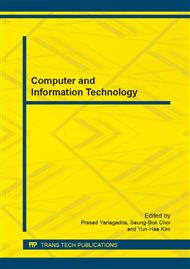[1]
R. Van. Nee and R. Prasad, OFDM for Wireless Multimedia Communications,. Norwood, MA: Artech House, (2000).
Google Scholar
[2]
S. H. Han and J. H. Lee, An overview of peak-to-average power ratio reduction techniques for multicarrier transmission, IEEE Wireless Commun., VOL. 12, NO. 2, p.56–65, Apr. (2005).
DOI: 10.1109/mwc.2005.1421929
Google Scholar
[3]
A. E. Jones, T. A. Wilkinson, and S. K. Barton, Block coding scheme for reduction of peak to mean envelope power ratio of multicarrier transmission schemes, Elec. Lett., vol. 30, no. 25, p.2098–2099, Dec. (1994).
DOI: 10.1049/el:19941423
Google Scholar
[4]
S. A. Aburakhia, E. F. Badran, and D. A. E. Mohamed, Linear companding transform for the reduction of peak-to-average power ratio of OFDM signals, IEEE Trans. Broadcast, vol. 55, no. 1, p.155–160, Mar. (2009).
DOI: 10.1109/tbc.2009.2013987
Google Scholar
[5]
X. D. Li and L. J. Cimini, Jr., Effects of clipping and filtering on the performance of OFDM, IEEE Commun. Lett., vol. 2, no. 5, p.131–133, May (1998).
DOI: 10.1109/4234.673657
Google Scholar
[6]
G. Lu, P. Wu, and C. Carlemalm-Logothetis, Peak-to-average power ratio reduction in OFDM based on transformation of partial transmit sequences, Elec. Lett., VOL. 42, NO. 2, p.105–106, JAN. (2006).
DOI: 10.1049/el:20063607
Google Scholar
[7]
A. D. S. Jayalath and C. Tellambura, SLM and PTS peak-power reduction of OFDM signals without side information, IEEE Trans. Wireless Commun., VOL. 4, NO. 5, p.2006–2013, SEP. (2005).
DOI: 10.1109/twc.2005.853916
Google Scholar
[8]
L. Yang, R. S. Chen, Y. M. Siu, and K. K. Soo, PAPR reduction of an OFDM Signal by use of PTS with low computational complexity, IEEE Trans. Broadcast., VOL. 52, NO. 1, p.83–86, MAR. (2006).
DOI: 10.1109/tbc.2005.856727
Google Scholar
[9]
S. G. Kang, J. G. Kim, and E. K. Joo, A novel subblock partition scheme for partial transmit sequence OFDM, IEEE Trans. Broadcast., VOL. 45, NO. 3, p.333–338, SEP. (1999).
DOI: 10.1109/11.796276
Google Scholar
[10]
Jun Hou, Jianhua Ge, and Jing Li, Peak-to-Average Power Ratio Reduction of OFDM Signals Using PTS Scheme With Low Computational Complexity, IEEE TRANSACTIONS ON BROADCASTING, VOL. 57, NO. 1, pp.143-148, MARCH. (2011).
DOI: 10.1109/tbc.2010.2079691
Google Scholar
[11]
G.R. Hill, M. Faulkner and J. Singh, Reducing the peak-to-average power ratio in OFDM by cyclically shifting partial transmit sequences, ELECTRONICS LETTERS,Vol. 36,no. 6, pp.560-561, 16th March (2000).
DOI: 10.1049/el:20000366
Google Scholar
[12]
L. Yang, K. K. Soo, S. Q. Li, and Y. M. Siu, PAPR Reduction Using Low Complexity PTS to Construct of OFDM Signals Without Side Information, IEEE TRANSACTIONS ON BROADCASTING, VOL. 57, NO. 2, pp.284-290, JUNE. (2011).
DOI: 10.1109/tbc.2011.2122870
Google Scholar
[13]
Sinem Coleri, Mustafa Ergen, Anuj Puri, and Ahmad Bahai, Channel Estimation Techniques Based on Pilot Arrangement in OFDM Systems, IEEE TRANSACTIONS ON BROADCASTING, VOL. 48, NO. 3, pp.223-229 , SEPTEMBER. (2002).
DOI: 10.1109/tbc.2002.804034
Google Scholar
[14]
Hosokawa, S.; Ohno, S.; Teo, K.A.D.; Hinamoto, T.;, Pilot Tone Design for Peak-to-Average Power ratio Reduction in OFDM, Circuits and Systems, 2005. ISCAS 2005. IEEE International Symposium on, VOL. 6, pp.6014-6017, MAY. (2005).
DOI: 10.1109/iscas.2005.1466010
Google Scholar
[15]
Lili Guan, Tao Jiang, Daiming Qu, and Yang Zhou, Joint Channel Estimation and PTS to Reduce Peak-to-Average-Power Radio in OFDM Systems Without Side Information, IEEE SIGNAL PROCESSING LETTERS, VOL. 17, NO. 10, pp.883-886, OCTOBER (2010).
DOI: 10.1109/lsp.2010.2066562
Google Scholar
[16]
Hyunju Kim, Student Member, IEEE, Eonpyo Hong, Member, IEEE, Changjun Ahn, and Dongsoo Har, A Pilot Symbol Pattern Enabling Data Recovery Without Side Information in PTS-Based OFDM Systems, IEEE TRANSACTIONS ON BROADCASTING, VOL. 57, NO. 2, pp.307-312, JUNE. (2011).
DOI: 10.1109/tbc.2011.2105611
Google Scholar


